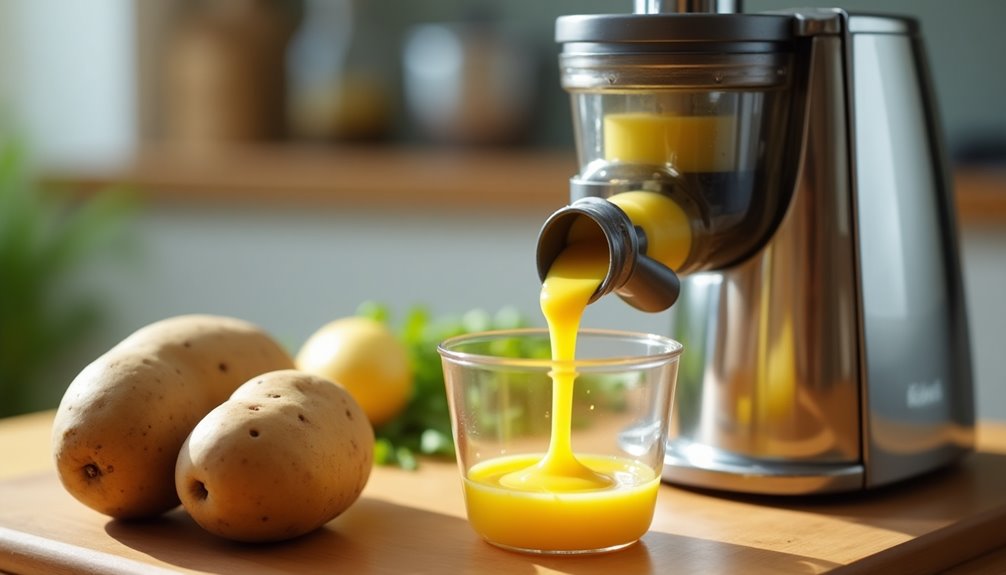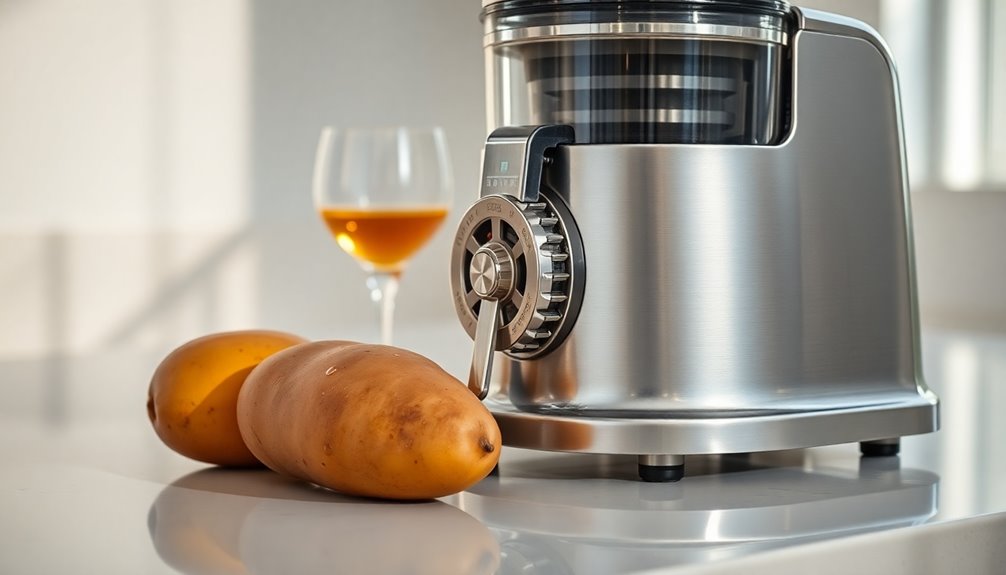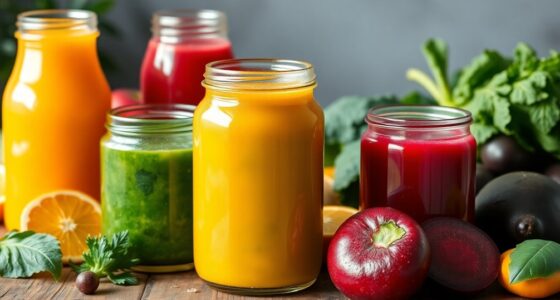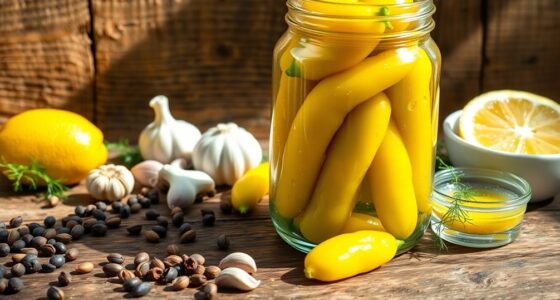Juicing a potato is simple! Start with raw, unpeeled, well-washed potatoes. Cube them into small pieces, then blend until smooth, adding a bit of water if needed. Strain through a mesh strainer to extract the juice, pressing the pulp to get every drop. Potato juice has a mild flavor, so you can mix it with other fruits or veggies like carrots for added nutrition. If you stick around, you'll discover even more tips and benefits!
Key Takeaways
- Select raw, unpeeled potatoes, ensuring they are well-washed and free of dark spots or greenish areas.
- Cube the potatoes into small pieces to facilitate easier juicing.
- Blend the potato cubes until smooth, adding a little water if using a blender for liquid consistency.
- Strain the blended mixture through a mesh strainer to extract juice, pressing the pulp to maximize yield.
- Consume the juice immediately for maximum nutrients, storing any leftovers in an airtight jar in the refrigerator.

Juicing a potato might sound unusual, but it's a simple way to tap into its nutritional benefits. Potatoes are often overlooked as a juice ingredient, yet they're a fantastic source of vitamins, especially vitamin C. By incorporating potato juice into your routine, you can enjoy a range of health benefits that come from this versatile vegetable. Not only is it packed with nutrients, but it's also incredibly easy to prepare.
To start juicing a potato, choose raw, unpeeled potatoes that are well-washed and free from dark spots or any greenish color. These signs indicate spoilage or the presence of toxins, which you definitely want to avoid. Once you've selected your potatoes, cube them into small pieces. This step is important for easier juicing whether you're using a juicer or a food processor. If you're opting for a blender, add a little water to the potato cubes to help achieve a liquid-like consistency.
Once you've blended the potato, you'll need to strain the mixture through a mesh strainer. This allows you to extract the juice while leaving behind the pulp. To maximize the yield, press the pulp gently with a spoon. You might be surprised at how much juice you can get from just a few potatoes! The resulting potato juice will have a mild flavor, making it a great base for mixing with other ingredients.
For optimal nutritional benefits, it's best to consume potato juice soon after preparing it. The nutrients, especially the vitamin C, are most potent right after juicing. Make sure to mix the juice well before drinking, as the nutrient-rich paste tends to settle at the bottom. If you want to enhance the flavor and nutrient profile, consider experimenting with combinations of potatoes and other vegetables or fruits, like carrots and celery. This not only boosts the taste but also adds an array of vitamins and minerals to your drink.
If you find yourself with leftover juice, store it in an airtight jar in the refrigerator. However, be mindful that the nutritional quality and flavor can diminish over time. It's best to consume your potato juice fresh for maximum health benefits.
Incorporating potato juice into your diet can be an innovative way to boost your vitamin intake. The juice provides a unique, nutritious option that you mightn't have considered before. Whether you're looking to mix it up in your morning routine or add another healthy beverage to your repertoire, juicing a potato can be an excellent choice. So grab your potatoes, a little water, and a food processor or blender, and start enjoying the nutritional benefits of this often-overlooked vegetable!
Frequently Asked Questions
Can You Juice Raw Potatoes?
Yes, you can juice raw potatoes. They're packed with nutrients like vitamin C and potassium, making them a healthy choice.
Just make sure you use fresh potatoes, free from dark spots or green discoloration. When you juice them, you’ll want to drink it immediately to get the most benefits. Additionally, it’s important to wash the potatoes thoroughly before juicing to remove any dirt or pesticides. If you’re looking to enhance the flavor and nutritional value of your juice, consider juicing fresh guava at home; its natural sweetness can complement the earthiness of the potatoes beautifully. This combination not only provides a delicious drink but also packs a powerful punch of vitamins and antioxidants.
Keep in mind, though, moderation is key, as excessive consumption can lead to stomach issues, especially for those with diabetes.
How Do You Get the Juice Out of a Potato?
To get the juice out of a potato, start by chopping it into small cubes.
If you've got a juicer, just feed the cubes in while it's running on a high setting.
If you're using a blender, add a bit of water and blend until smooth, then strain it to separate the juice from the pulp.
Don't forget to stir the juice before drinking to mix in all the nutrients!
How Do You Squeeze Liquid Out of Potatoes?
To squeeze liquid out of potatoes, you'll start by chopping them into small pieces, then blend those cubes with a splash of water.
After blending, strain the mixture, capturing the juice while leaving the pulp behind.
If you prefer, use a juicer instead, feeding in the cubed potatoes directly.
Remember to stir the juice before drinking, mixing in all those valuable nutrients.
Enjoy it fresh to reap the most benefits!
How Do I Prepare Potato Juice?
To prepare potato juice, start by selecting fresh, unpeeled potatoes without dark spots.
Wash them thoroughly, then cut them into small cubes. If you're using a blender, add a little water to help the blending process.
Blend or juice the cubes, then strain the mixture to separate the liquid from the pulp.
For extra flavor, you can mix in ingredients like carrots or apples.
Remember to drink it fresh for the best nutritional benefits!
Conclusion
Now that you know how to juice a potato, you might be wondering about the incredible benefits waiting for you. Imagine the vibrant, fresh juice, brimming with nutrients and potential. But what if there's more than meets the eye? As you sip that earthy elixir, consider the mysteries hidden within each drop. Could this simple root hold the key to a healthier you? Only time will tell, but one thing's for sure: you're about to embark on a delicious journey.
Cindy thoroughly researches juicing trends, techniques, and recipes to provide readers with practical advice and inspiration. Her writing style is accessible, engaging, and designed to make complex concepts easy to understand. Cindy’s dedication to promoting the advantages of juicing shines through her work, empowering readers to make positive changes in their lives through the simple act of juicing.











